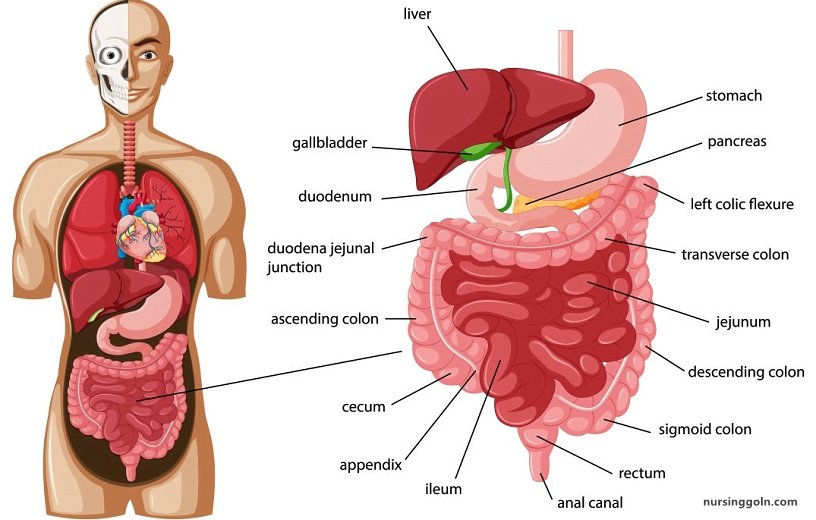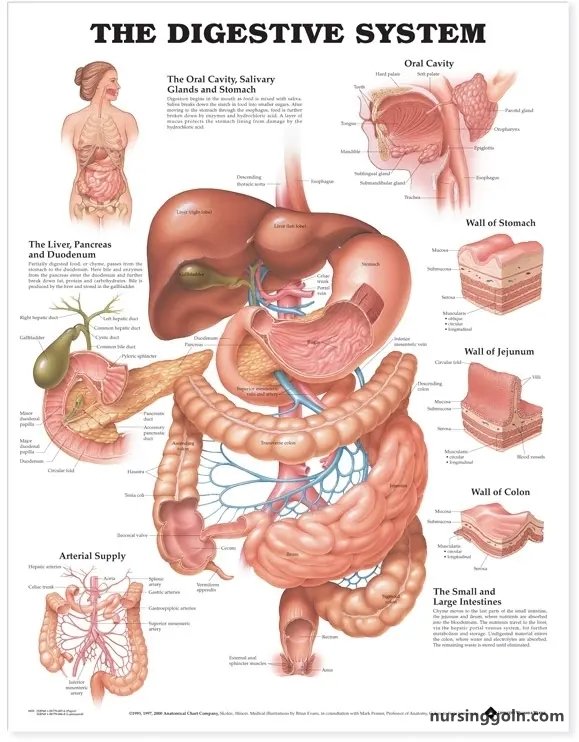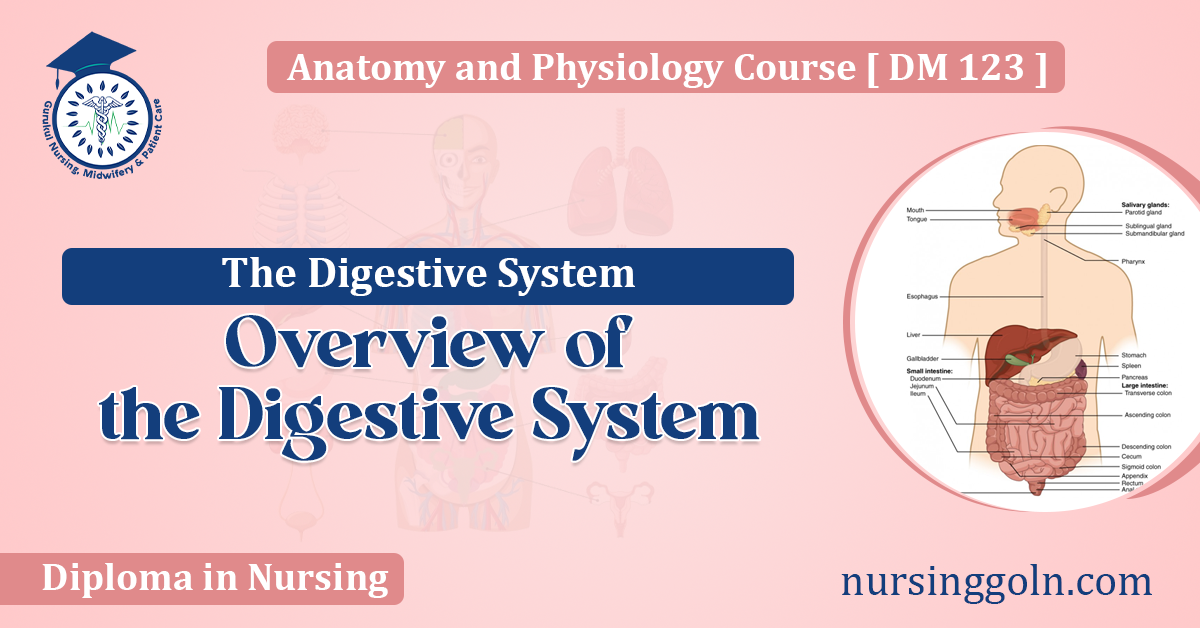Today our topic of discussion is ” Overview of the Digestive System “. The digestive system is a complex and wondrous network of organs and tissues responsible for breaking down food into its essential components, absorbing nutrients, and eliminating waste. This intricate process is vital for sustaining life, providing the body with the energy and raw materials it needs to function. In this article, we will embark on a journey through the digestive system, exploring its anatomy, functions, and the remarkable processes that occur within it.
Overview of the Digestive System: The Digestive System

1. The Digestive System’s Anatomy
The digestive system consists of various organs, each with a unique role in the overall process of digestion. These organs can be categorized into two groups: the alimentary canal (or gastrointestinal tract) and accessory digestive organs.
Alimentary Canal:
The alimentary canal is a continuous, muscular tube that begins at the mouth and ends at the anus. It is responsible for the ingestion, propulsion, digestion, absorption, and elimination of food. The main components of the alimentary canal include:
a. Mouth: The digestive journey begins in the mouth, where food is ingested and broken down by mechanical and chemical processes. Chewing, or mastication, reduces food into smaller particles, while salivary glands secrete saliva containing enzymes that initiate the breakdown of carbohydrates.
b. Pharynx: The pharynx serves as a common passageway for both food and air. During swallowing, the epiglottis prevents food from entering the airway.
c. Esophagus: This muscular tube carries food from the pharynx to the stomach through peristaltic contractions, rhythmic waves of muscular contractions.
d. Stomach: The stomach is a J-shaped organ where food is temporarily stored and further digested. It secretes gastric juice, a highly acidic mixture of enzymes and hydrochloric acid, which assists in breaking down proteins and killing harmful bacteria.
e. Small Intestine: The small intestine is the longest part of the alimentary canal and is where the majority of digestion and nutrient absorption occurs. It is divided into three sections: the duodenum, jejunum, and ileum. The pancreas and liver, both accessory organs, secrete digestive enzymes and bile into the duodenum to aid in the digestion of fats, carbohydrates, and proteins.
f. Large Intestine: The large intestine is responsible for absorbing water and electrolytes and forming and storing feces. It comprises the cecum, colon, rectum, and anal canal. The colon is further divided into the ascending colon, transverse colon, descending colon, and sigmoid colon.
g. Anus: The digestive journey concludes at the anus, where waste materials are eliminated from the body through defecation.
Accessory Digestive Organs:
Accessory digestive organs are not part of the alimentary canal but play crucial roles in digestion by producing and releasing digestive secretions. These organs include:
- Salivary Glands: Located in the mouth, they secrete saliva containing amylase, an enzyme that initiates carbohydrate digestion.
- Liver: The largest internal organ, the liver produces bile, a substance that emulsifies fats, breaking them into smaller droplets to enhance digestion and absorption.
- Pancreas: The pancreas releases digestive enzymes, such as amylase, lipase, and proteases, into the small intestine to facilitate the digestion of carbohydrates, fats, and proteins.

2. The Digestive Process
The digestive process is a well-coordinated sequence of mechanical and chemical events. It can be summarized into several key steps:
a. Ingestion: The process begins with the intake of food into the mouth.
b. Mastication: Chewing, or mastication, reduces food into smaller, more manageable particles. Saliva is secreted during this phase, containing the enzyme amylase, which initiates the breakdown of starches into simpler sugars.
c. Deglutition (Swallowing): The act of swallowing pushes food from the mouth into the pharynx and esophagus, where peristaltic contractions propel it toward the stomach.
d. Stomach Digestion: Once in the stomach, food mixes with gastric juice, creating a semi-liquid substance called chyme. Gastric enzymes, primarily pepsin, digest proteins. The stomach’s acidic environment also helps kill potentially harmful microorganisms in the ingested food.
e. Small Intestine Digestion and Absorption: The chyme moves into the small intestine, where the majority of digestion and nutrient absorption occur. The pancreas secretes digestive enzymes and the liver secretes bile into the duodenum. These enzymes further break down carbohydrates, fats, and proteins. The surface area of the small intestine is significantly increased by villi and microvilli, which are covered in absorptive cells. This allows for efficient nutrient absorption into the bloodstream.
f. Large Intestine Processing: The remaining undigested material enters the large intestine, where water and electrolytes are absorbed, and feces are formed. The gut microbiota in the large intestine also play a role in fermentation, producing gases and certain vitamins.
g. Elimination: Finally, the formed feces are stored in the rectum until they are expelled from the body through the anus.

3. Regulatory Mechanisms of Digestion
The digestive process is intricately regulated to ensure the efficient breakdown and absorption of nutrients. Several key mechanisms come into play:
a. Nervous System: The enteric nervous system, which is embedded in the gastrointestinal tract, regulates many digestive processes independently. Additionally, the autonomic nervous system, consisting of the sympathetic and parasympathetic branches, influences digestion. The parasympathetic system stimulates digestion, while the sympathetic system inhibits it.
b. Hormonal Regulation: Various hormones, such as gastrin, cholecystokinin (CCK), and secretin, are released to control the secretion of digestive enzymes, gastric acid, and bile. These hormones are typically triggered by the presence of food in the digestive tract.
c. Local Factors: Mechanical and chemical changes within the digestive tract, like stretching of the stomach wall and changes in pH, also influence digestive processes. These local factors often work in concert with nervous and hormonal regulation.

4. The Role of Microbiota in Digestion
The human gut is home to trillions of microorganisms, collectively known as the gut microbiota. These microorganisms play a critical role in digestion and overall health. They help digest complex carbohydrates, produce certain vitamins (like vitamin K and some B vitamins), and contribute to the fermentation of dietary fibers.

5. Digestive System and Nutrient Absorption
The digestive system serves as the gateway for nutrient absorption. Different nutrients are absorbed in different parts of the digestive tract:
- Carbohydrates: These are broken down into simpler sugars (glucose, fructose, and galactose) and absorbed in the small intestine.
- Proteins: Proteins are broken down into amino acids, which are absorbed in the small intestine.
- Fats: Fats are emulsified by bile and broken down into fatty acids and monoglycerides in the small intestine. These products are absorbed and then reassembled into triglycerides, forming chylomicrons for transport through the lymphatic system.
- Vitamins and Minerals: These essential micronutrients are absorbed at various sites in the small intestine. Vitamin B12, for instance, requires the presence of intrinsic factor, a protein secreted by the stomach, for absorption.

6. Digestive Disorders and Conditions
The digestive system is susceptible to various disorders and conditions, including:
- Gastroesophageal Reflux Disease (GERD): Characterized by chronic acid reflux, which can lead to esophageal damage.
- Peptic Ulcers: Open sores that form on the lining of the stomach or the duodenum, often caused by Helicobacter pylori infection.
- Irritable Bowel Syndrome (IBS): A chronic condition characterized by abdominal pain, bloating, and changes in bowel habits.
- Inflammatory Bowel Disease (IBD): An umbrella term for chronic inflammatory conditions of the gastrointestinal tract, including Crohn’s disease and ulcerative colitis.
- Celiac Disease: An autoimmune condition in which the ingestion of gluten triggers an immune response that damages the small intestine.
- Gallstones: Solid particles that form in the gallbladder, often causing pain and discomfort.
- Pancreatitis: Inflammation of the pancreas, which can lead to digestive enzyme leakage and tissue damage.
- Colorectal Cancer: Cancer that begins in the colon or rectum and often starts as polyps.
7. The Role of Diet in Digestive Health
Diet plays a significant role in digestive health. Consuming a balanced diet rich in fiber, fruits, vegetables, and lean proteins can help support proper digestion and prevent gastrointestinal disorders. Adequate hydration is also crucial for maintaining healthy digestive processes.

8. Future Perspectives in Digestive Health
Advancements in medical science, such as the development of minimally invasive surgical techniques and innovative diagnostic tools, continue to improve the treatment and management of digestive disorders. Furthermore, ongoing research on the gut microbiota and its influence on health and disease holds promise for personalized approaches to digestive health.

The digestive system is a remarkable example of biological complexity and adaptability. From the initial ingestion of food to the absorption of essential nutrients, this intricate system ensures the body receives the sustenance it needs to function. Understanding the anatomy, functions, and regulatory mechanisms of the digestive system is essential for maintaining overall health and well-being. As we continue to explore the mysteries of digestion, we gain insights into how diet, lifestyle, and medical interventions can optimize digestive health and contribute to a higher quality of life.
